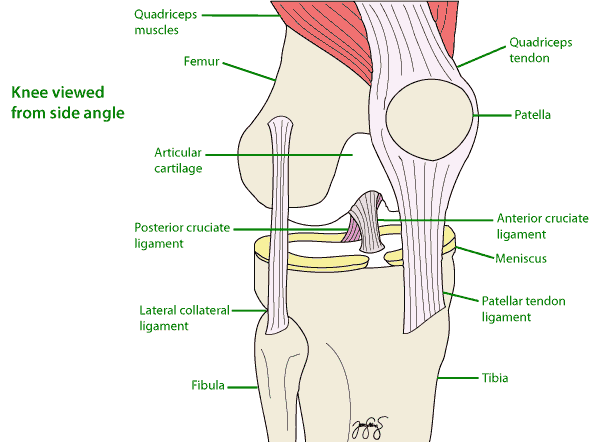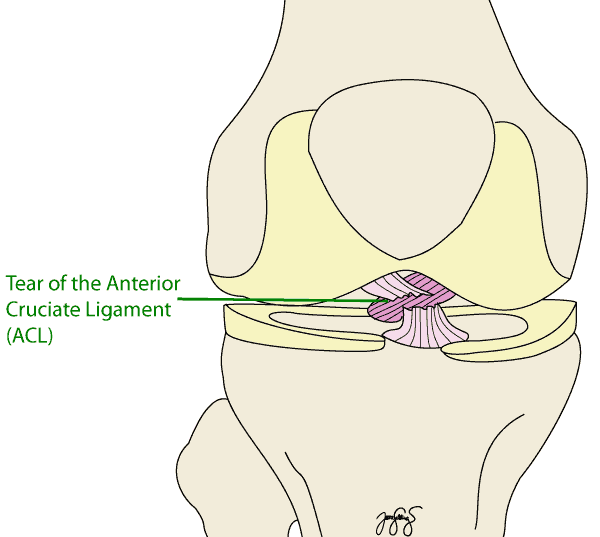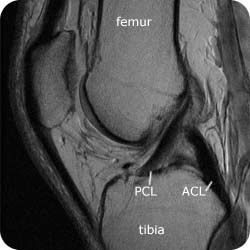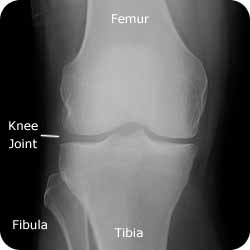
The Anterior Cruciate Ligament (ACL) is an important ligament which is found in the middle of your knee joint. Its purpose is to keep your knee stable, especially when doing movements like running quickly in different directions.
A tear in this ligament can make your knee feel loose or not stable, and your knee can feel like it may give out.
Symptoms
Symptoms that you may notice at the time of ACL injury may include:
- A sudden “pop” sound in the knee
- Swelling of the knee within minutes to hours of the injury. This is caused by bleeding into the knee
- Moderate to severe pain in the knee
Symptoms that may occur days to weeks after the injury include:
- Giving way: After the swelling improves you may feel a sense of ‘instability’ in the injured knee. This means the knee moves around too much and may lead to the knee giving way. This is often felt during activities such as squatting, walking down stairs, pivoting on the knee or stepping sideways.
- Ongoing knee pain
- Ongoing swelling (usually less severe than at the time of injury)

Diagram of a tear of the Anterior Cruciate Ligament
When to see your doctor
If you experience any of the symptoms of ACL injury it is important to go and see a doctor. Generally the longer you take to seek treatment the longer it will take to recover.
Causes
A tear in your ACL usually occurs when you are doing sport. Occasions when it is very common is when you slow down very suddenly to change your direction. Some sports which are more likely to cause an ACL tear are soccer, basketball, martial arts and gymnastics. This is because they involve jumping, running with sharp turns, quick stops and pivoting.
Investigations
Your doctor will thoroughly examine your knee in a variety of positions before actually ordering tests.

A Xray of the Right Knee showing normal anatomy

A MRI showing normal knee anatomy and an intact ACL
Your doctor may order x-rays or an MRI scan to better see the inside of your joint.An MRI is less likely to be ordered and the way it works is by using magnetic fields to create an image of the soft tissues of your knee.
Complications
A short term complication is that you will need to take it easy until your injured ligament has healed.
Other complications may include:
- Torn meniscus: As the ACL and meniscus are both structures in your knee which are quick close, if you injure one you may have injured the other. An injured meniscus can increase the risk of joint problems later on.
- Arthritis: This is a very common complication that arises as a long term complication.This is when your joint cartilage gets rough over time leaving it deficient . About half the people with an ACL tear develop osteoarthritis in the involved joint 10 to 20 years later. Arthritis may occur even if you have surgery to reconstruct the ligament.
Treatment
The aims of treatment for an ACL injury are to reduce pain and swelling in your knee, restore the normal joint movement and strengthening the muscles around your knee.
There are many options which are available for you
Short term
To treat the immediate injury:
- Use RICE (rest, ice, compression, elevation)
- Take pain relievers such as ibuprofen as needed
- You can use an elastic bandage around your knee
- Use a splint or walk with crutches if needed
Surgery
To surgically repair your ligament, a piece of tendon from another part of your leg is used to replace it.
Surgery may be an option if:
- You are unable to continue doing your normal activities because of knee symptoms
- You’re very active and want to continue doing heavy work, sports or other recreational activities. However, sometimes this may not be practical.
- Other parts of your knee like the meniscus or other ligaments, are also injured
ACL surgery is a procedure using arthroscopic techniques. This means the surgeon puts a small instrument (arthroscope) with a light and a small camera into your knee via some an incision. This allows your surgeon to see the inside of your knee joint and repair your ACL.
After surgery you’ll have rehabilitation and may need a knee brace.
Nonsurgical rehabilitation
Sometimes surgery may not be necessary and the doctor will discuss the options with you.
This may be an appropriate choice for you as long as long as you’re willing to give up activities that place extra stress on your knee. You may want to consider rehabilitation alone if:
- You only have a partial tear of your ACL
- You don’t do sports that involve quick turning, pivoting or jumping. Or if you aren’t very active
- You already have advanced knee arthritis
Seeking Advice
Your Family Doctor (GP)
Your Family Doctor will be able to diagnose and help treat your problem. He or she will be able to
- tell you about your problem
- advise you of the best treatment methods
- prescribe you medications
- and if necessary, refer you to Specialists (Consultants) for further treatment
You’re likely to start by first seeing your family doctor (GP). However, in some cases when you call to set up an appointment, you may be referred immediately to an orthopedist, an orthopaedic surgeon or a sports medicine specialist.
Because appointments can be brief, and because there’s often a lot of ground to cover, it’s a good idea to be well prepared for your appointment. Here’s some information to help you get ready for your appointment, and what to expect from your doctor.
Bring along information about yourself
It can be a great help for your doctor if you bring along the following information about yourself
- A list of your medications, including the name and dosage.
- Information about your medical problems and past treatment
- Previous investigation results, such as xrays and blood tests.
Prepare a list of questions for your doctor
- Write down any symptoms you’re experiencing, including what you were doing when you first started experiencing the symptoms.
- Ask a family member or friend to join you, if possible. Sometimes it can be difficult to soak up all the information and treatment options provided to you during an appointment. Someone who accompanies you may remember something that you missed or forgot.
- Write down questions to ask your doctor.
Your time with your doctor is limited, so preparing a list of questions ahead of time will help you make the most of your appointment. List your questions from most important to least important in case time runs out. For an ACL injury, some basic questions to ask your doctor include:
- What’s the most likely cause of my problems?
- Are there other possible causes for my symptoms?
- Do I need any special tests or investigations? Will these tests definitively diagnose my condition?
- What treatment options are available?
- Which do you recommend for my situation?
- If I choose not to have surgery, how long might recovery take?
- If I don’t have surgery, what signs and symptoms would indicate a need for surgery?
- If I have surgery, what’s the average recovery time?
- What activity restrictions do I need to follow?
- Are there any fact sheets or printed information that I can take home with me to read?Are there any reliable websites that I can visit?
In addition to the questions that you’ve prepared to ask your doctor, don’t hesitate to ask questions during your appointment at any time that you don’t understand something.
What to expect from your doctor
Your doctor is likely to ask you a number of questions. Being ready to answer them may reserve time to go over any points you want to spend more time on. Your doctor may ask:
- When did you first begin experiencing symptoms?
- What were you doing at the time?
- Did you experience immediate swelling?
- Have your symptoms been continuous, or occasional?
- How severe are your symptoms?
- Does anything seem to improve your symptoms?
- What, if anything, appears to worsen your symptoms?
- Does your knee ever “lock” or feel blocked when you’re trying to move it?
- Do you ever feel that your knee is unstable or unable to support your weight?
What you can do in the meantime
If you’ve injured your knee, don’t move the joint. Use a splint to keep your knee protected in a comfortable position until a doctor examines it. Avoid returning to a sport or activity until you’ve had the injury evaluated.
Prevention
There are a few steps you can take to decrease the chance of getting an ACL injury:
- Firstly use proper sporting technique: Learning how to safely do actions in your sport like jumping or quick turning are easy ways to prevent injury. Also protective sporting equipment designed for that sport may be an option.
- Condition yourself: Many high performing athletes reduce their risk of ACL injury doing training drills. These routines incorporate things like agility, balance and power to help teach the muscle to react properly.
- Hamstring strengthening (especially for women): As women are at a higher risk of ACL injury they should take care to strengthen and stretch their muscles.
- Maintain fitness: If you’re on a seasonal sports team, stay active and fit throughout the year. This helps prevent you getting injured when your season starts.
Contrary to popular belief, using a knee brace during sports doesn’t reduce your risk of injury. It only provides a false sense of security.
F.A.Q. | Frequently Asked Questions
How long will it take to return to sports?
Everyone recovers at a different rate. The most standard answer that you will hear from the doctor is six months. It’s possible to return sooner than six months, but the risks for re-injury are higher. It takes about 12-18 months for your new ACL to be in peak condition. At six months, it is about 80-85%, this is considered to be strong enough to return to sports. Usually wearing a brace of some sort, but not always. My doctor doesn’t believe in any kind of bracing after recovery.
I feel weird pains in my knee, is this normal?
Yes. You have to remember that no matter how good doctors get at ACL surgery, it is still a major procedure that will effect you for a long time.
Will i need surgery?
It depends. ACL tears can be partial or complete. With stretching and strengthening exercises and often a good knee brace, it is possible to live with a tear. If you find you can not lead the life you wish and are unwilling to modify it, then surgery is for you. “Modify your life to fit your knee or modify your knee to fit your life” is the standard quote. However, surgery is frequently recommended for very active patients, particularly those involved in sports.
